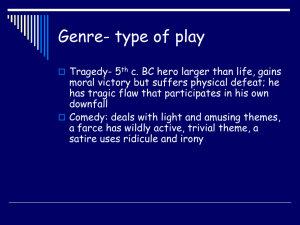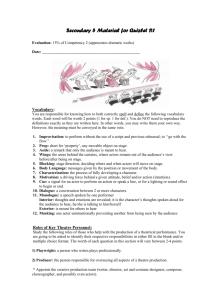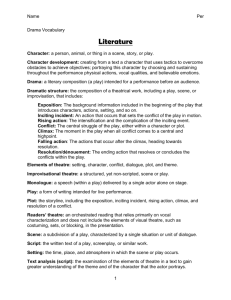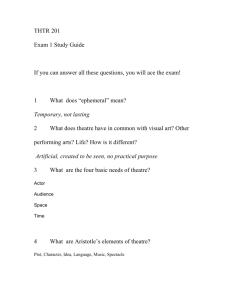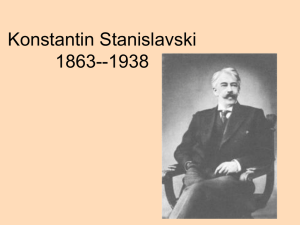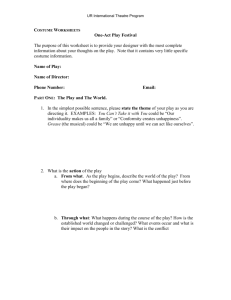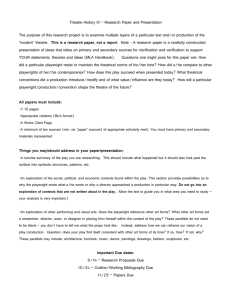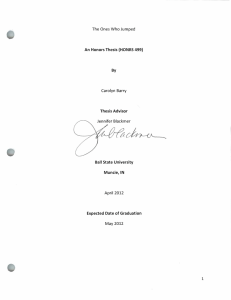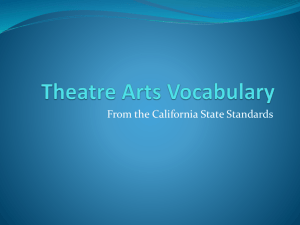theatre terms
advertisement
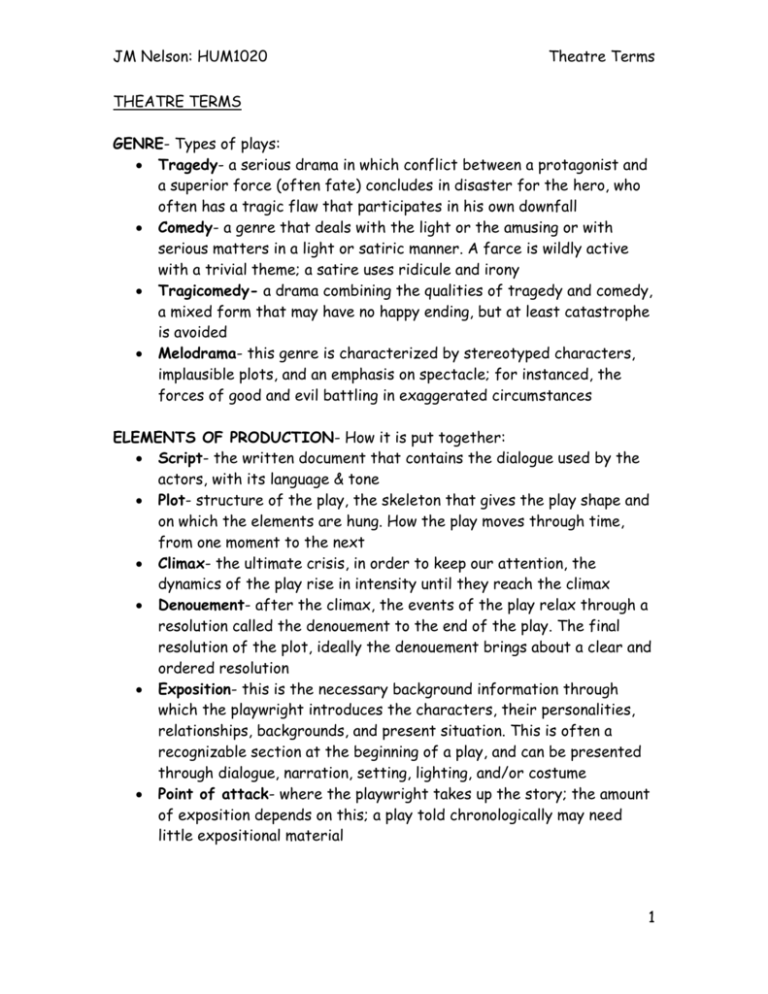
JM Nelson: HUM1020 Theatre Terms THEATRE TERMS GENRE- Types of plays: Tragedy- a serious drama in which conflict between a protagonist and a superior force (often fate) concludes in disaster for the hero, who often has a tragic flaw that participates in his own downfall Comedy- a genre that deals with the light or the amusing or with serious matters in a light or satiric manner. A farce is wildly active with a trivial theme; a satire uses ridicule and irony Tragicomedy- a drama combining the qualities of tragedy and comedy, a mixed form that may have no happy ending, but at least catastrophe is avoided Melodrama- this genre is characterized by stereotyped characters, implausible plots, and an emphasis on spectacle; for instanced, the forces of good and evil battling in exaggerated circumstances ELEMENTS OF PRODUCTION- How it is put together: Script- the written document that contains the dialogue used by the actors, with its language & tone Plot- structure of the play, the skeleton that gives the play shape and on which the elements are hung. How the play moves through time, from one moment to the next Climax- the ultimate crisis, in order to keep our attention, the dynamics of the play rise in intensity until they reach the climax Denouement- after the climax, the events of the play relax through a resolution called the denouement to the end of the play. The final resolution of the plot, ideally the denouement brings about a clear and ordered resolution Exposition- this is the necessary background information through which the playwright introduces the characters, their personalities, relationships, backgrounds, and present situation. This is often a recognizable section at the beginning of a play, and can be presented through dialogue, narration, setting, lighting, and/or costume Point of attack- where the playwright takes up the story; the amount of exposition depends on this; a play told chronologically may need little expositional material 1 JM Nelson: HUM1020 Theatre Terms Complication- this is something that frustrates the normally expected course of events, giving the audience a reason to be interested in the outcome. Inciting incident- introduces the complication. The inciting incident is an action or decision that upsets the current state of affairs, and opens the middle part of the play or the complication. Foreshadowing- preparation for subsequent action, it provides credibility for future action, and moves the play forward by pointing to events that will occur later Discovery- revelation of information about characters, their personalities, relationships, and feelings Reversal –any turn of fortune. In comedy it often changes the roles of the social classes Character- the psychological motivation of the persons in play; Interest in the drama lies in the exploration of how persons with specific character motivations react to the circumstances they find themselves in Protagonist- central personage, we journey through the workings of the play by the actions and decisions of the protagonist. This is not always clear, and may depend upon who the director chooses to focus Theme- the ideas that comprise the intellectual content of the play; not necessarily the plot, which is what the play is about, but the thought behind the play which is for us to discover and develop There are three aspects of this a) The playwright’s idea, b) The interpretation of the director & his decisions, and c) The audience’s perception VISUAL ELEMENTS Theatre types- the theatre setting provides aesthetic distance. This allows us to become involved in what we know is fictitious. Our response to a production is shaped by the design of the space in which the play is produced. 1. Arena- the audience surrounds the playing area on all sides 2. Thrust- a three-quarter theatre, in which the audience surrounds the playing area on three sides 3. Proscenium- the audience sits on one side only and views the action through a frame 2 JM Nelson: HUM1020 Theatre Terms Scene design (stage setting) - the purpose is to create an environment conducive to the production’s ends. The same tools of composition are used- line, form, mass, color, repetition, and unity- as in painting. Also, since the stage design occupies three-dimensional space and must allow for the movement of the actors, the set or scene designer is also a sculptor. The scene designer is limited by the stage space and concepts of the director, as well as the abilities of the staff available to execute the design. Lighting design- the lighting designer works to sculpt with light and shadows; they must enhance the color of a costume, accent the physique of an actor and reinforce the plasticity of a setting. They reinforce the dramatic structure and dynamics of the play, working within the framework of light and shade. Without shadows and highlights, the human face and body become imperceptible. Stage Costuming- costume designers work with the entire body of the actor including hair styles and makeup to suit a specific purpose. Stage costuming has three functions: 1. accents which actors are the most important, and shows the relationships between them 2. reflects- a particular era, time of day, climate, season, location, or occasion 3. reveals -the style of the performance, the characters of the personages, and the personages’ social position, profession, cleanliness, age, physique, and health Properties- two groups: 1. Set props- these are part of the set design, such as furniture, pictures, rugs, fireplace accessories, etc. They identify the mood of the play and the character of those who inhabit the world they portray 2. Hand props- these are used by the actors to help portray characters, such as cigarettes, papers, glasses, etc. Properties can be significant to our understanding of a playif all is neat and in order as the curtain opens, but as the play develops the actors disrupt the properties, that transition can help illustrate what may have happened Aural elements- this also contributes to our understanding of the play. It includes background music, the actor’s voices, and sound effects 3 JM Nelson: HUM1020 Theatre Terms Dynamics – this is the structural pattern of a play, the patterns help to hold the interest of the audience. The production must employ devices whereby our interest can peak and relax. The director controls where and how high these peaks occur by controlling the volume & intensity of the actors. The Actor: the main channel of communication between the playwright and the audience. The actor’s portrayal of a role that enhance our response and understanding are two-fold: 1.) Speech, or the manner in which the lines (written by the playwright) are delivered; the actor’s interpretation of the lines 2) Physical reinforcement of the character’s motivation. The consistency of the motivations drives the decisions and actions of the actor. These further aid our understanding of the play. 4

